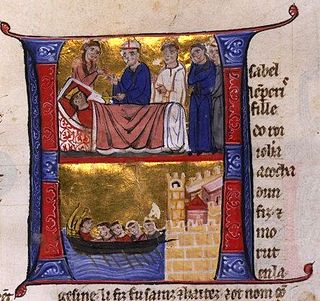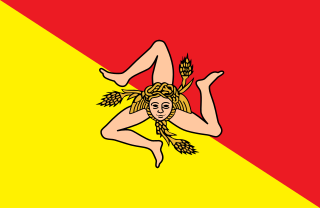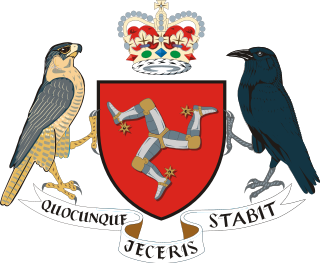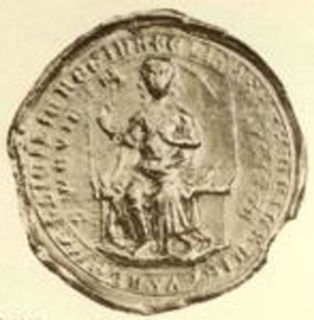
Sicily is the largest island in the Mediterranean Sea and one of the 20 regions of Italy. It is one of the five Italian autonomous regions and is officially referred to as Regione Siciliana. The region has 5 million inhabitants. Its capital city is Palermo.

Frederick II was the regent of the Kingdom of Sicily from 1291 until 1295 and subsequently king of Sicily from 1295 until his death. He was the third son of Peter III of Aragon and served in the War of the Sicilian Vespers on behalf of his father and brothers, Alfonso ΙΙΙ and James ΙΙ. He was confirmed as king by the Peace of Caltabellotta in 1302. His reign saw important constitutional reforms: the Constitutiones regales, Capitula alia, and Ordinationes generales.

Isabella II, also known as Yolande of Brienne, was a princess of French origin, the daughter of Maria, the queen-regnant of Jerusalem, and her husband, John of Brienne. She was reigning Queen of Jerusalem from 1212 until her death in 1228. By marriage to Frederick II, Holy Roman Emperor, Isabella also became Holy Roman Empress and Queen of Sicily and Germany.

The Kingdom of Naples, also known as the Kingdom of Sicily, was a state that ruled the part of the Italian Peninsula south of the Papal States between 1282 and 1816. It was established by the War of the Sicilian Vespers (1282–1302), when the island of Sicily revolted and was conquered by the Crown of Aragon, becoming a separate kingdom also called the Kingdom of Sicily. In 1816, it reunified with the island of Sicily to form the Kingdom of the Two Sicilies.

Martin the Humane, also called the Elder and the Ecclesiastic, was King of Aragon, Valencia, Sardinia and Corsica and Count of Barcelona from 1396 and King of Sicily from 1409. He failed to secure the accession of his illegitimate grandson, Frederic, Count of Luna, and with him the rule of the House of Barcelona came to an end.

Frederick III, called the Simple, was King of Sicily from 1355 to 1377. He was the second son of Peter II of Sicily and Elisabeth of Carinthia. He succeeded his brother Louis. The documents of his era call him the "infante Frederick, ruler of the kingdom of Sicily", without any regnal number.

The flag of the Isle of Man or flag of Mann is a triskelion, composed of three armoured legs with golden spurs, upon a red background. It has been the official flag of Mann since 1 December 1932 and is based on the Manx coat of arms, which dates back to the 13th century.

The Kingdom of Sicily was a state that existed in the south of the Italian peninsula and for a time the region of Ifriqiya from its founding by Roger II of Sicily in 1130 until 1816. It was a successor state of the County of Sicily, which had been founded in 1071 during the Norman conquest of the southern peninsula. The island was divided into three regions: Val di Mazara, Val Demone and Val di Noto; val being the apocopic form of the word vallo, derived from the Arabic word wilāya.
Louis the Child was King of Sicily from 15 September 1342 until his death. He was a minor upon his succession, and was under a regency until 1354. His actual rule was short, for he died in an outbreak of plague the next year. His reign was marked by civil war.

The flag of Sicily shows a triskeles symbol, and at its centre a Gorgoneion and a pair of wings and three wheat ears.

The Coat of Arms of the Isle of Man, blazoned Gules three legs in armour flexed at the knee and conjoined at the thigh, all proper, garnished and spurred or, dates from the late 13th century. The present version dates from 12 July 1996. As the Isle of Man is a Crown dependency and the present Lord of Man is Queen Elizabeth II of the United Kingdom, the arms are more accurately described as the Arms of Her Majesty in right of the Isle of Man. The origin of the triskeles is obscure, but it appears to stem from the Scottish takeover of the island in 1265. The heraldic supporters are birds associated with the island, whilst the motto first appears on record in the 17th century.
The Peace of Caltabellotta, signed on 31 August 1302, was the last of a series of treaties, including those of Tarascon and Anagni, designed to end the conflict between the Houses of Anjou and Barcelona for ascendancy in the Mediterranean and especially Sicily and the Mezzogiorno.

The War of the Sicilian Vespers or just War of the Vespers was a conflict that started with the insurrection of the Sicilian Vespers against Charles of Anjou in 1282 and ended in 1302 with the Peace of Caltabellotta. It was fought in Sicily, Catalonia and elsewhere in the western Mediterranean between the kings of Aragon on one side against the Angevin Charles of Anjou, his son Charles II, the kings of France, and the Papacy on the other side. The war resulted in the division of the old Kingdom of Sicily; at Caltabellotta, Charles II was confirmed as king of Sicily's peninsular territories, while Frederick III was confirmed as king of the island territories.

Eleanor of Anjou was Queen of Sicily as the wife of King Frederick II of Sicily. She was a member of the Capetian House of Anjou by birth.

Elisabeth of Bavaria, a member of the House of Wittelsbach, was Queen consort of Germany and Jerusalem from 1246 to 1254 by her marriage to King Conrad IV of Germany.
Constance of Aragon was an Aragonese infanta who was by marriage firstly Queen of Hungary, and secondly Queen of Germany and Sicily and Holy Roman Empress. She was regent of Sicily from 1212–1220.

Beatrice of Rethel was a French noblewoman and Queen of Sicily as the third wife of Roger II.
The Treaty of Villeneuve (1372) was the definitive agreement that ended the dispute between the House of Anjou and the House of Barcelona over the Kingdom of Sicily that began ninety years earlier in 1282. Its final form was approved by Pope Gregory XI in a bull issued at Villeneuve-lès-Avignon on 20 August 1372, and it was ratified by Queen Joan I of Naples and King Frederick IV of Sicily on 31 March 1373 at Aversa, in Joan's kingdom, in front of the papal legate, Jean de Réveillon, Bishop of Sarlat.













